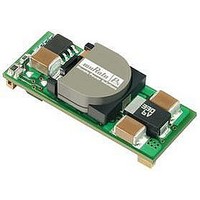LSN-5/16-D12-C Murata Power Solutions Inc, LSN-5/16-D12-C Datasheet - Page 8

LSN-5/16-D12-C
Manufacturer Part Number
LSN-5/16-D12-C
Description
DC/DC Converter
Manufacturer
Murata Power Solutions Inc
Series
LSNr
Datasheet
1.LSN-516-D12-C.pdf
(13 pages)
Specifications of LSN-5/16-D12-C
Dc / Dc Converter O/p Type
Fixed
No. Of Outputs
1
Input Voltage
10V To 14V
Power Rating
80W
Output Voltage
5V
Output Current
16mA
Supply Voltage
12V
Dc / Dc Converter Case Style
SIP
Product
Non-Isolated / POL
Output Power
80 W
Input Voltage Range
10 V to 14 V
Input Voltage (nominal)
12 V
Number Of Outputs
1
Output Voltage (channel 1)
5 V
Output Current (channel 1)
16 A
Package / Case Size
SIP
Output Type
Low Voltage Reversed Pin
Lead Free Status / RoHS Status
Lead free / RoHS Compliant
Voltage Margining
The LSN-T/16-D12 converter can serve as the power source for a production
test environment using voltage margining. This gives the capability to vary
the net output voltage up or down for stress and functional testing of a target
system over the expected power supply voltage range.
primary precision trim resistor and two voltage margining resistors. The
switches are typically low on-resistance FET transistors acting as switches.
Devices specifi cally designed for analog switch applications have effective
closed resistance of a few Ohms and often have a logic gate driving them.
LSN-T/16-D12 may be adjusted up or down a fi xed amount by installing sub-
trim voltage margining resistors as shown on the attached circuit. In effect, an
additional voltage divider is switched in one leg at a time to slightly raise or
lower the output voltage. Typical FET switches are the Maxim MAX4643 and
MAX4544 families.
resistors and switches close to the converter with short leads. Be aware that
the effective output voltage is the result of all error sources including the trim
resistor accuracies and temperature coeffi cients. Also, the resulting trim resis-
tor from the equations is usually not a standard precision value therefore you
may have to parallel two resistors.
ing. Do not turn on both resistors simultaneously. Also, do not exceed the total
power output of the converter.
Voltage margining requires three external resistors and two switches – the
After installing the desired trim resistor, the constant voltage output on the
As with the primary trim resistor, by sure to mount these voltage margining
CAUTION: Switch in only one resistor at a time to invoke voltage margin-
Figure 5. LSN-T/16-D12 Voltage Margining
www.murata-ps.com
Output Reverse Conduction
Many DC/DC's using synchronous rectifi cation suffer from Output Reverse
Conduction. If those devices have a voltage applied across their output before
a voltage is applied to their input (this typically occurs when another power
supply starts before them in a power-sequenced application), they will either
fail to start or self destruct. In both cases, the cause is the "freewheeling" or
"catch" FET biasing itself on and effectively becoming a short circuit.
tion. They employ proprietary gate drive circuitry that makes them immune to
applied output voltages.
Thermal Considerations and Thermal Protection
The typical output-current thermal-derating curves shown below enable
designers to determine how much current they can reliably derive from each
model of the LSN D12 SIP's under known ambient-temperature and air-fl ow
conditions. Similarly, the curves indicate how much air fl ow is required to reli-
ably deliver a specifi c output current at known temperatures.
whose heat is generated primarily by I
developed using thermocouples to monitor the inductor temperature and vary-
ing the load to keep that temperature below +110°C under the assorted condi-
tions of air fl ow and air temperature. Once the temperature exceeds +115°C
(approx.), the thermal protection will disable the converter. Automatic restart
occurs after the temperature has dropped below +110°C.
air fl ow was parallel to the unit in the direction from pin 11 to pin 1.
curves on the following pages, LSN D12 SIP's maintain virtually constant
effi ciency from half to full load, and consequently deliver very impressive
temperature performance even if operating at full load.
ously subject to numerous factors and tolerances not taken into account here.
If you are attempting to extract the most current out of these units under
demanding temperature conditions, we advise you to monitor the output-
inductor temperature to ensure it remains below +110°C at all times.
LSN D12 SIP DC/DC converters do not suffer from Output Reverse Conduc-
The highest temperatures in LSN D12 SIP's occur at their output inductor,
All but the last two DUT's were vertical-mount models, and the direction of
As you may deduce from the derating curves and observe in the effi ciency
Lastly, when LSN D12 SIP's are installed in system boards, they are obvi-
Single Output, Non-Isolated, 12V
Technical enquiries email: sales@murata-ps.com, tel:
LSN-16A D12 Models
16 Amp in DC/DCs SIP Packages
MDC_LSN 16A D12 Models.B03 Page 8 of 13
2
R losses. The derating curves were
IN
, 0.75-5V
+1 508 339 3000
OUT



















